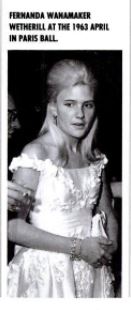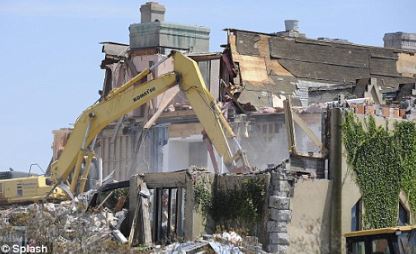Ocean Castle on Meadow Lane
- Tom Edmonds

- Jun 14, 2022
- 6 min read
Updated: Sep 1, 2022

It is 1929, the year the economy will take a spectacular plunge, but William F. Ladd, too rich to fret over ominous signs, has set his heart on spending the Fourth of July in Southampton in the oceanfront house of his dreams.

Never mind that the house does not yet exist, that he already has mansions further west on Long Island and in Florida, and that he has only a bare six months to meet his deadline. With a great fortune said to derive in part from huge sugar plantation holdings in Cuba and supplemented by a rich clientele that depends on him for investment advice, he presses ahead with his plan. He commissions the prestigious architectural firm Peabody, Wilson & Brown – designer of his Long Island mansion as well as several formidable Southampton “cottages” -- and asks Archibald Brown to pull out all the stops. The firm is to make his dream a reality, and to do so in six months flat!

So begins the wild flurry of activity that brings the fantasy to life on the spit of sand that separates the Atlantic from Shinnecock Bay. Ocean Castle is a multi-room fairytale dwelling that dips and winds along the oceanfront dunes for an awesome 300 feet. To some observers it looks like an entire French fishing village with its tile roof and cobblestone courts. A more modest original plan expands to include additional wings along with three towers, a dovecote and more. Mid-construction Ladd realizes that the view of ocean and bay will be much improved if the house is raised on stilts, a whim that requires amazing feats of engineering and staggering amounts of sand brought in to reconfigure the terrain with man-made dunes.
Old exteriors of Ocean Castle
Miraculously the goal is achieved and as the stock market begins its downward spiral that will have investors jumping out windows in October, Ladd is able to celebrate the Fourth at Ocean Castle. If he is spared the ruinous fate of so many other wealthy capitalists, it is probably not entirely attributable to his financial genius. Rather it is quite likely that his income is substantially boosted by a bootlegging operation run out of the Castle. Prohibition is in full effect and Ladd is alleged to have shipped Cuban sugar to Florida stills as a prime ingredient for bootleg liquor, which subsequently lands on the beach at Ocean Castle. Legend has it that the hooch then passes through a smuggler’s door into a concrete storage cell (the vaults are said to remain) where it is kept until trucks arrive in the dead of night to whisk it off to Manhattan speakeasies.
Old exterior of Ocean Castle and an entry hall
Ladd marries three times, the last in September 1948 at the age of 63. As Steven Gaines writes in Philistines at the Hedgerow, just six months after the ceremony at Ocean Castle, Ladd is diagnosed with cancer and given only a few weeks to live. In despair he writes a note of apology to his bride and shoots himself in the mouth at his Palm Beach residence. Unfortunately, the shot is not fatal and he lingers for another three months before dying.

The house is sold after Ladd’s death and causes little comment as it passes through various owners until 1963. That summer Donald Leas Jr, with his own mansion, Westerly, booked solid, rents Ocean Castle from its then-owner, Robert Harris, to use as a guesthouse over the Labor Day weekend. He plans to use it to house the overflow of young men invited to attend the debutante ball of his stepdaughter, Fernanda Wanamaker Wetherill. Known for their extravagant parties, Leas and his heiress wife–favorites among the Southampton social set–are expected to go all out for the beautiful Fernanda, whose activities as a budding socialite are already being chronicled in the society press.
But it is not the spectacular ball with its 800 guests, pink three-pole tent, and “twist band” that makes national headlines. It is the infamous “after party” at Ocean Castle where the male guests, the so-called cream of their generation, fueled by too much drink and excitement, throw off their fine breeding in a wild Dionysian outburst and trash the place. They swing from the rafters, throw the furniture onto the beach and smash 1600 window panes. The press loves the story and there is an orgy of public hand-wringing over the nihilism of the new generation. In the end, retired cotton broker and champion of conservative causes Robert Harris does not want to press charges for the damage to his house and though public pressure for a trial prevails, it ends in wholesale acquittal. Entitlement, money and excellent lawyers win the day.

In 1978, the eccentric theater producer Roy Radin pays a reported $300,000 in cash for Ocean Castle and a second wave of scandal is about to wash over the prized oceanfront mansion. Radin, whose goal in life is to be a recognized bigshot, is freakishly fat, vaguely satanic beneath his big-spender bonhomie, and addicted to cocaine. Predictably, his audacity in taking title to this prized estate on a piece of real estate understood to be the preserve of the summer elite, is greeted with shudders over at the Meadow Club. But Radin is not out to impress high society.
He is awash with money from the proceeds of the retro vaudeville shows he produces and dispatches to parts of the country where has-beens like Tiny Tim and Red Buttons can still draw a crowd. In a brilliant move, he partners with Police Benevolent Association, touting the shows as fundraisers for law enforcement, while pocketing the lion’s share of the proceeds. Staff, all required to live on the premises, tend to a constant flow of guests among whom are models and movie stars. On outings to local bars and restaurants with his entourage, Radin never fails to pick up the check and is sometimes observed sending drinks to a beautiful diner who has caught his eye. If the gesture is accepted, he may follow up with an invitation to end the evening at Ocean Castle, now well known in the village as a venue for wild, drug-fueled parties.

A trickle of leaks from staff and others, offering details of the parties and other unsavory goings-on at Ocean Castle, turns to a flood following an incident that ends Radin’s convenient association with the police, brings down the Roy Radin Review, and gives the press a scandal out in the Hamptons to run with. It happens on a weekend in April 1980 when Melonie Haller, a recent Playboy Magazine playmate-of-the-month and a weekend guest at Ocean Castle is found unconscious on the 8:42 a.m. train to Penn Station. Questioned later, she describes a nightmarish party that night when guests dressed in leather cavorted drunkenly. At some point in the wee hours, she contends, the fun turned violent and she was sexually assaulted.
In his account, Radin admits to the alcohol and the outfits but takes serious issue with Haller’s story when it comes to the attack. In any case, the police are obliged to end their financial relationship with him, the curtain comes down on the variety shows, and Radin looks to Hollywood to realize his bigshot ambitions. He lists Ocean Castle for sale and as soon as it hits the market a buyer snaps it up for a reported $8 million-plus. Bicoastal now, Radin sets off in May for a business meeting in Beverly Hills, which he hopes will set him up as a bigtime movie producer. But his willingness to deal with underworld figures finally catches up with him and he is never again seen alive. Weeks later his bullet-riddled body is found in a dry creek bed north of Los Angeles.
Only slightly less eccentric than Radin, Barry Trupin, who succeeds him as the proud owner of Ocean Castle, is also in possession of a vast fortune, the origins of which remain carefully guarded by the “determinedly private” Trupin. Having purchased the former Henry F. du Pont mansion down the road called Chestertown House in 1979, he is now in need of temporary quarters for himself and his wife Renee while his crews transform the Georgian Chestertown House into an ersatz French Gothic castle he calls Dragon’s Head. But that is another story.
Turin’s reconstructs Chestertown House (left) into Dragon’s Head (right).
Some of the swarming crews at Dragon’s Head are redeployed at Ocean Castle to satisfy the opulent tastes of the Trupins. James Collins recalls hanging a priceless chandelier in their “temporary home” and working on a bed for Renee built to her specifications. Medieval armor and two taxidermist bears in attack position from Barry’s collection are moved in to make him feel at home, and the Trupins host a lavish medieval-themed party there at the apex of their good fortune in 1984. It is too good to last, however, and Trupin’s Southampton dream comes to an ignominious end when light is shed on the mysterious source of his wealth and he is convicted as a tax scoff-law and sentenced to prison.
Barry Trupin’s 1939 Lagonda V12 and the destruction of Dragon’s Head
In recent years things have quieted down at Ocean Castle. Despite the challenges of maintaining such a vast seaside structure, the late Julia Vance Carter, a lawyer and real estate investor who purchased Ocean Castle in the late 1980s, made it a comfortable summer home for her family. In a 1999 interview she mentioned that she was still finding shards of glass on the grounds from the 1963 debacle. After her death in 2014, the house remained in her estate until its recent purchase in February, “trading hands between LLC’s,” for a reported $70 million.
Interiors of Ocean Castle today


























